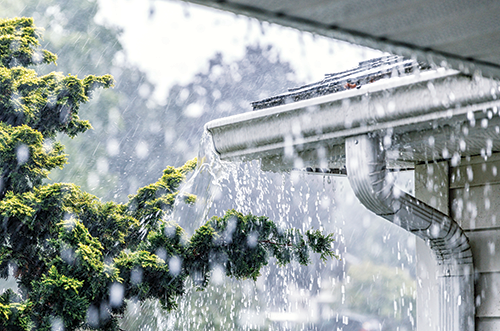Rain Damage: Prepare Your Home or Business

Rain can be a blessing, especially in drought-prone areas, but water damage from rain is not typically welcomed. Heavy rainfall can have a quick and devastating impact on homes and buildings, marring roofs and siding or causing sump pumps and drains to overflow. Personal and/or commercial property can be ruined and, in some cases, additional expenses may be incurred as necessary repairs undergo completion.
Properly preparing and maintaining your property can help mitigate problems caused by rainfall.
We offer several tips here.
CLEAR A PATH FOR RUNOFF
Avoiding rain damage can be as simple as making sure the water has somewhere to go, which is why gutter and downspout maintenance is essential.
- Clean Gutters
Clogged gutters, downspouts, and scuppers can cause water to backup and damage your roof. Clear these of debris at least twice a year. - Trim Trees
Trim any surrounding trees away from your roof to prevent clogs (leaves and sticks can build up in gutters) and to prevent premature aging of the roof which can lead to water infiltration. - Align Gutters
If there is any standing water in your gutters, adjust them so they gently slope toward the downspout. - Aim Downspouts
Funnel water by ensuring downspout endings are pointing away from buildings, preventing water from accumulating at foundations or flooding basements.
PREVENT LEAKS
- Inspect Roofs
- Inspect the roof for any shingle damage. Missing or cracked shingles pose a threat to future rain damage, and black grit building up in gutters can be a sign of the shingles deteriorating.
- Seal up any loose flashing around the edge of the roof. This can be done with outdoor caulk or a waterproof tape.
- Check curbing around equipment on top of a commercial roof for leaks or rotting, and clear those areas of debris as well.
- Secure Air Conditioners
- Proper installation of wall air conditioner (AC) units can significantly reduce water entry during severe storms. Ensure caulking and weather stripping around the unit is intact. If the AC has an internal drain pipe, check that it’s adequate and water can flow freely.
- Install or reconfigure the AC unit with an outward angle – a ¼-inch bubble or 2-degree tilt – to effectively reduce water entry.
DRAINAGE CHECK
- Check the Sump Pump
Ensure the functionality of the sump pump by operating it at least quarterly.
Like all mechanical devices, it will fail eventually. Clean the sump pump at least once a year, removing dirt, gravel, and other debris. This can extend the life of the pump and is crucial to avoid heavy rains damaging the foundation or basement. - Clean Drains
Like gutters, storm drains can collect debris such as leaves, sticks, dirt, and litter, but all rainwater running off your home or business must go somewhere. Clear storm drains regularly if on your property.
DID YOU KNOW?
Most property insurance policies do NOT cover expenses for water damage associated with wear-and-tear, lack of maintenance, and other causes. Check your policy for “covered perils” and/or consult with your insurance agent to learn more.
HELPFUL RESOURCES
Disastersafety.org
http://disastersafety.org/rain
Insurance Information Institute
iii.org/article/how-protect-your-home-water-damage
Disclaimer: The GUARD Wire is designed to provide general information about various topics of interest and should NOT replace the guidance, advice, or recommendations from licensed insurance or legal professionals, other industry experts, or state and federal authorities.


